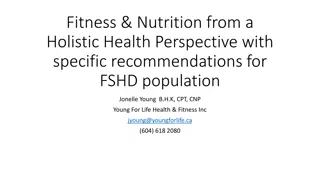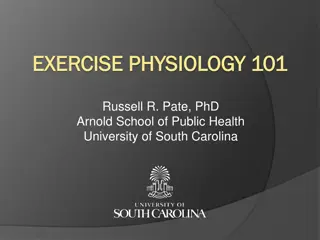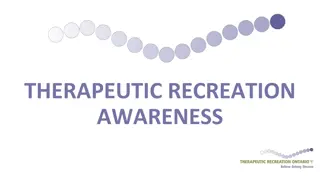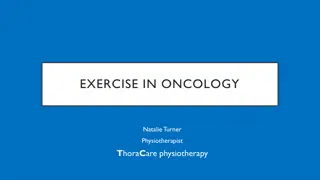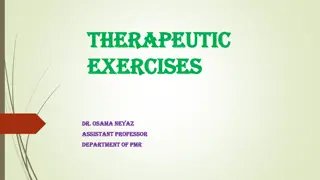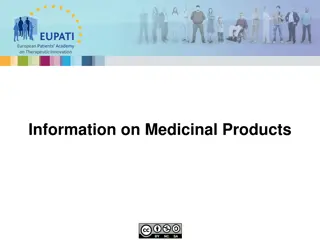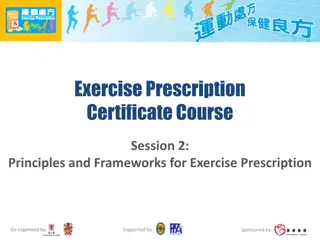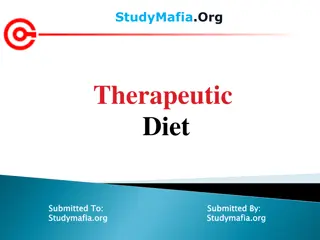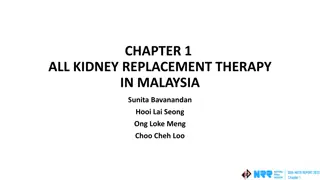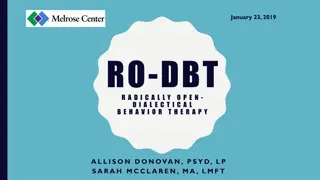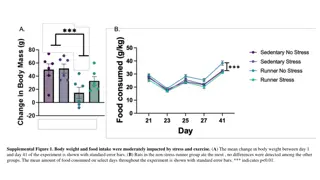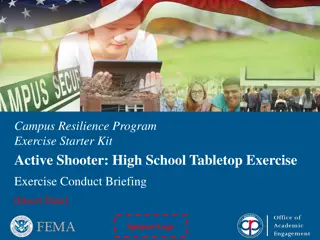Understanding Exercise Considerations for FSHD Patients: Research and Therapeutic Insights
Explore the significance of exercise for individuals with Facioscapulohumeral Muscular Dystrophy (FSHD) through research findings and therapeutic strategies. Delve into topics like active aging, functional capacity, cognitive-behavioral therapy effects, and more to optimize health and well-being for FSHD patients.
Download Presentation

Please find below an Image/Link to download the presentation.
The content on the website is provided AS IS for your information and personal use only. It may not be sold, licensed, or shared on other websites without obtaining consent from the author. Download presentation by click this link. If you encounter any issues during the download, it is possible that the publisher has removed the file from their server.
E N D
Presentation Transcript
FSH Society Family Day SF FSHD Exercise Richard Gee, PT, Stanford Children s Health. 15 July, 2017
Goals Review research exercise Discuss exercise considerations Discuss Physical therapy Questions and answers
World Health Organization framework; active aging Active aging is the process of optimizing opportunities for health, participation and security in order to enhance quality of life as people age. It applies to both individuals and population groups. The word active refers to continuing participation in social, economic, cultural, spiritual and civic affairs, not just the ability to be physically active or to participate in the labor force. contributors to their families, peers, communities and nations.
Functional Capacity Kalache 1997
International Classification of Function Disability and Health (ICF)
Muscular Dystrophy: Kevins Story https://www.cdc.gov/features/musculardystrophy/index.html
Research; FACT2 protocol FSHD trial Aerobic training effect and Cognitive-behavioral therapy effect on chronic fatigue of patients FSHD 57 participants in three groups. Aerobic, CBT, traditional. 16 week intervention, 12 week follow up Aerobic and CBT groups lower fatigue level and better physical performance CBT group Better sleep quality and social participation. - - - - Aerobic activity Cognitive-behavioral therapy are positive; less fatigue. Voet NG, et al, Neurology 2014
Model of perpetuating factors of experienced fatigue in patients with FSHD. Positive; improve muscle strength, reduce pain, optimize physical activity and alleviate experienced fatigue. negative factor; falling and avoidance ; impact on physical activity and social participation Voet NG, et al, Neurology 2014
Research; cycle ergometer Aerobic training with patients FSHD -8 patients with FSHD. -12 weeks cycle ergometer, -35 min sessions, for 44 sessions -Training increased: Oxygen uptake increased. -Maximal workload increased, -Improved self report strength, endurance, and level of activity Aerobic activity is likely positive; Low intensity aerobic training improved fitness. David Olsen. Nerology 2005
Research academic report ; cycling and strength training. Safety and efficacy of a home based exercise program in patients with FSHD 6 months in a training and control group Cycling 3 times weekly for 35 minute, 24 weeks, Combined with strength training(not described) -improved training, improved endurance, 6min walk test. Combined strength and interval cycling are likely positive and safe Barkole Am Phys Rehabil Med 2005
How much physical activity do adults need? 2008 Physical Activity Guidelines for Americans 2 hours and 30 minutes (150 minutes) of moderate-intensity aerobic activity(i.e., brisk walking) every week 30 minutes per day for 5 days. 10 minutes at a time is fine (Same time as watching a movie) https://www.cdc.gov/physicalactivity/basics/adults/index.htm
How much physical activity do adults need? 2008 Physical Activity Guidelines for Americans And muscle-strengthening activities on 2 or more days a week work all major muscle groups (legs, hips, back, abdomen, chest, shoulders, and arms). https://www.cdc.gov/physicalactivity/basics/adults/index.htm
Physical Therapy and FSHD Physical Therapy for Facioscapulohumeral Muscular Dystrophy Kate Eichinger, PhD, Shree Pandya, PT, MS Windy King, PT http://www.fshsociety.org/wp- content/uploads/2014/09/FSH-Society-PT- Brochure-Web-Version.pdf
Additional considerations. Aerobic : cycling, Arm ergometer, Nustep, Maintain muscle strength. Note muscle imbalances Body weight, elastic bands, Weights; monitor weight, repetition, fatigue Range of motion in the joints; avoid overstretch
. Swimming and water exercises for strengthening without causing stress. Balance Exercise should not be done to the point of exhaustion Energy conservation. Assistive devices, mobility devices, orthotics,
Pain Management Common sites of pain are lower back, legs, shoulders, and neck. 10.8% of patients have significant pain. Goal is to improve muscle strength and function. Minimize injury from falls Minimize injury from overuse. Minimize postural dysfunction. Medical followup Physical therapy referral.
Perceived Exertion Scale How do we measure Exertion or Intensity
What are your goals? Monitor pain fatigue Maximize Function Optimize Active participation Prevent falls Improve Safety


